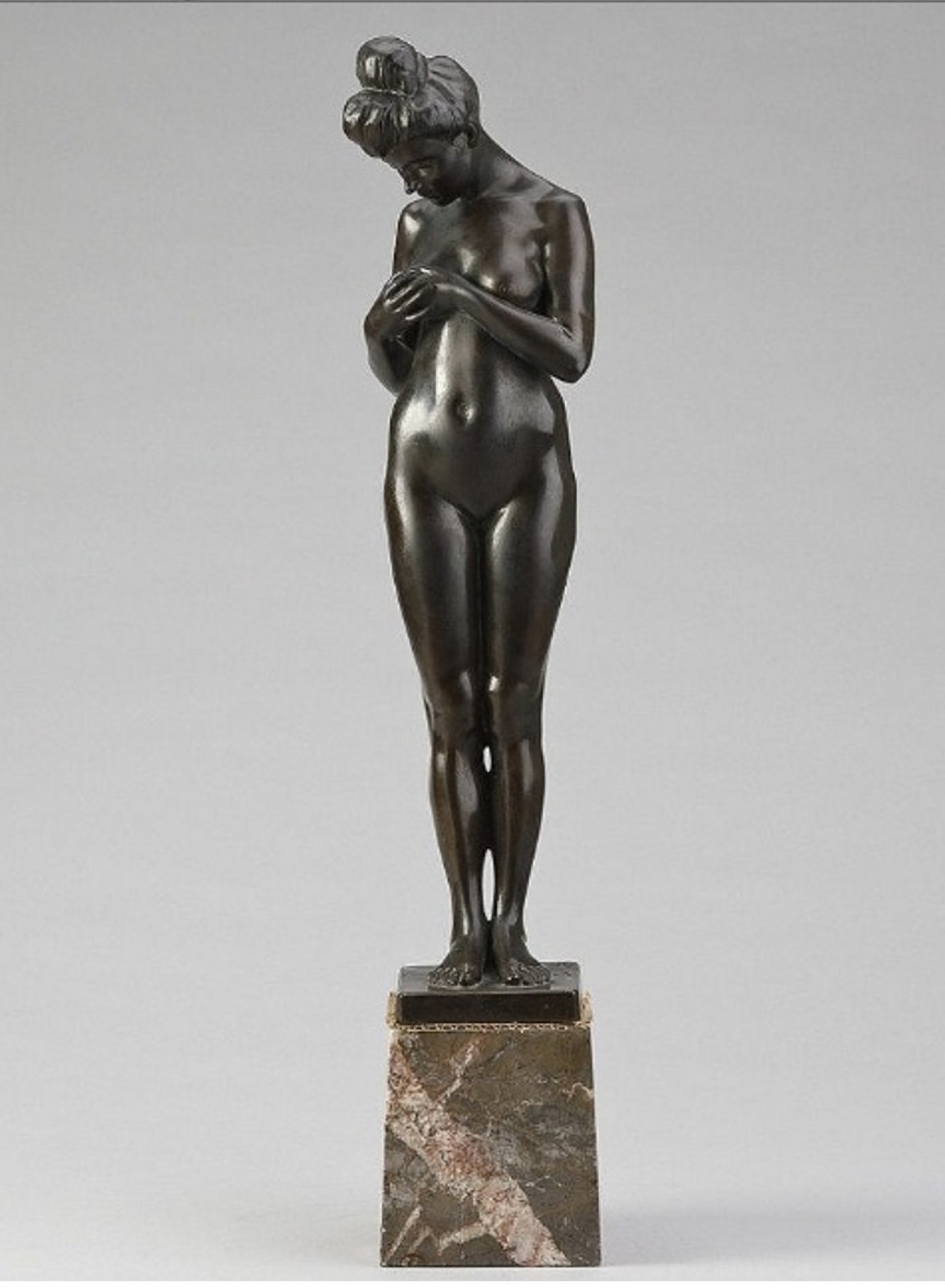Gustave Michael Pillig
(Standing nude holding her breast)
bronze
signed and dated 'G. Pillig 1906’ on top of bronze base, inscribed ‘Bronceguss v. B. Förster Dusseldorf ' on side of bronze base.
53.1
cm
$8500 including GST
This is one of Pillig’s finest early sculptures. It was produced prior to the artist’s emigration to Australia, and shows the classical influence of his German training, and the sophisticated artistic sensibility he brought with him to this country. Although he played a notable role in the Melbourne art world between the wars the quality of these sculptures was only occasionally emulated, and his work became increasingly eccentric before being abandoned altogether.
Gustav Michael Pillig was born on 30 September 1877 near Essen, Germany, and lived in Düsseldorf from 1883. In 1900 he studied art at the Institute of Technology in Stockholm, from 1901 to 1903 at the Academy in Berlin, and finally from 1905 to 1907 at the Düsseldorf Art Academy. From 1905 to 1911 Pillig was a member of the renowned Düsseldorf artist-club, Paintbox. He produced at least five significant public memorial sculptures: the Dr. Hugo Schulze Monument in front of the Mining School in Bochum; the memorial of the Right Hon. Lord Mayor Zweigert on the Horst Emscher Bridge, Essen; the memorial tomb of the Kirdorf Family Vault at Aachen; the monument of the General Director Emil Müller at Troisdorf, near Bonn and that of the Privy Councillor H. A. Bueck.
In 1910 Pillig moved to Berlin, but returned to Dusseldorf in 1913. While in Berlin he met the philosopher Oswald Spengler (1880-1936) who theorized that the current civilization was about to end. Spengler apparently influenced Pillig who, in 1913, is said to have believed in a looming catastrophic war and it was apparently this belief that led him to emigrate to Australia.
In Melbourne Pillig produced art works in a variety of media, primarily sculpture and oil paintings but also art deco glazed pottery portraits as well as etchings. (Pillig’s 1932 exhibition of 43 works at Everyman's Library, 832 Collins Street, Melbourne included plaques and book-ends and a sculpture of Phar Lap). He worked on the figurative panels for Hoyt's Regent Theatre in Melbourne and was in charge of the designing of decoration and the figure modelling for the Hoyt's Plaza Theatre.
In 1921 Pillig exhibited 5 sculptures at the Society of Artists in Sydney, including ‘Bacchanal’ which was highly priced at 100 guineas. In 1922 he exhibited 4 sculptures with the Society of Artists including Sorrow, and Despair. These presumably had as their subject the suffering experienced in the First World War. In 1932 he exhibited 3 sculptures including, Pan & Nymphe, at the Victorian Artists Society. In the same year, in a group exhibition at the Athenaeum Gallery, Pillig exhibited 20 paintings and sculptures in various media (including a bronze of Pan, another sculpture titled Awakening and a terracotta titled Grief). He exhibited a bronze bust of Henry Lawson at the Bread and Cheese Club in 1940. He held several solo exhibitions organized by the gallerist Max Herbert Enkhardt who appears to have been Pillig’s mentor in Melbourne.
In a review of Pillig’s work (in ‘The Star,’ 30th October, 1933) fellow artist Clewin Harcourt wrote: ‘...He has lived in Australia for 20 years, yet his techniques and outlook are still German.
’ Pillig’s pessimistic world view appears to have intensified in the Depression years when he was working on his grandiose work titled Symphony of Life which was exhibited in 1932 at the Pan Salon, Little Collins street, Melbourne. It was an 18 x 10 foot diorama comprising about 350 small, modeled figures against a painted background with about 1000 figures, topped by an oversized painted figure of Christ. Pillig apparently wished to express the themes of Oswald Spengler's book The Decline of the West. When it was exhibited the work received a bemused response. In a note in the exhibition catalogue Pillig claimed the work was ‘a pearl in an ocean of artistic flotsam and jetsam’ but when reviewing the exhibition for The Argus (8 November, 1932) Arthur Streeton wrote: ‘That line might prepare one to look for a very great masterpiece. If the work had been designed and painted by Tintoretto it would have been a masterpiece’.
Pillig, embittered that Symphony of Life had not received proper recognition, destroyed it in 1940. Despite the lack of success with this work and its destruction it remains a striking example of a work by an artist in Australia in the 1930s grappling ambitiously with international political issues.
Gustav Pillig died in modest circumstances in 1956 in Melbourne.
The following online sources have been helpful in compiling the above information:
Hans H. Hanke, ‘A Westphalian in Australia - the sculptor Gustav Pillig’. In Monuments in Westfalen-Lippe. Westphalian Conservation Office. Münster Issue 2 / 1999, pp. 68-70.
www.artibeau.de
A catalogue of known works as well as other biographical details is to be found at http://www.gustavpillig.info/


